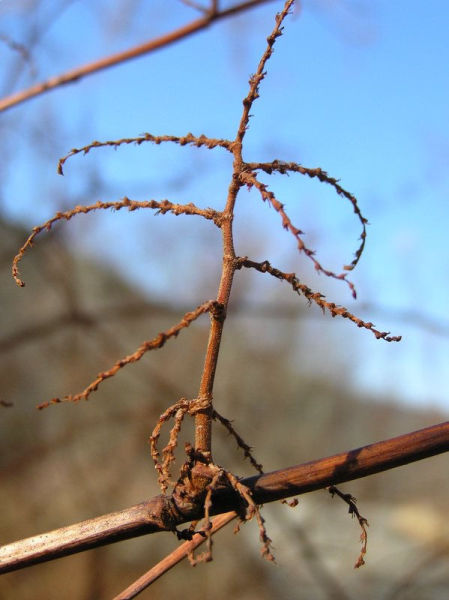
I can usually identify this plant in a heartbeat, but I was stumped when I saw this photograph. Maybe you will be too, so I’ve made it a quiz.
Here are some clues:
- The plant is a perennial native of Asia.
- It’s invasive in North America wherever it’s found.
- The stems are hollow and stand over 10 feet tall, persisting through the winter.
- The plant spreads by wind-borne seeds and rhizomes.
- The rhizomes are particularly difficult to eradicate and result in dense stands of this plant.
- It was originally brought here as an ornamental because it’s flowers are arranged in pretty cream-colored sprays above the stems. (This is the flower stalk in winter.)
- The young stems are edible and taste like rhubarb but Americans don’t like it well enough it to reduce its population by harvesting.
Do you know what it is? Leave a comment with your answer.
(photo by Dianne Machesney)
Hogweed?
Is it Japanese Knotweed (Fallopia japonica, syn. Polygonum cuspidatum, Reynoutria japonica)?
Given the shape of the flower head, I’m guessing Japanese Knotweed.
The dreaded Japanese knotweed. The dead twisted seed heads line the Yough between Confluence and Ohiopyle.
Hi Kate!
Sound like Knotweed. There used to be a festival in spring around it, but I’m not sure if that has continued.
Bamboo?
I am thinking Japanese Knotweed….I think so far I have kept it from the yard, but not easy to do, it’s at the end of our road….this takes over creek and river banks….not a good way to control unless you keep ahead, you get the plant before the roots literally take hold…even putting heavy dark tarps and plastic doesn’t kill it…very, very agressive!!!
Does this plant have thorns, and are the stems red?
I have no idea what this plant is, but I’m thinking I’ve seen this all over the fields.
Is it a wild grape vine?
I’m guessing it must be Japanese Knotweed, but that took some detective work on my part. Definitely don’t get any credit if this wasn’t an “open-book quiz.”
Looking at the pictures of it in summer, it does seem familiar. I’ll have to keep my eyes open as summer comes around.
Perhaps Japanese knotweed?
Is it bamboo?
i believe it is a member of the Polygonaceae family, ‘Polygonum cuspidatum’, commonly known as Japanese Knotweed.
i’m going to guess….japanese knotwood with some sort of gall or other parasite.
Too early for responses? How about Japanese knotweed?
Hi Kate,
Japanese Knotweed.
Just checking on Perigrine falcons if back in town and where they may have gone this winter?
Great blog. I should look here more often.
Best Regards,
Steve
Great responses, everyone! Yes, it’s the dreaded Japanese knotweed.
I’m used to the look of the plant as a whole but not this small piece of it. I found some yesterday next to Highland Park reservoir. It’s everywhere!!
p.s. Steve Coleman, peregrine news is easily accessible in my “Peregrines” category here: http://www.birdsoutsidemywindow.org/category/peregrines/ The peregrines are definitely in town.
BUT ….. keep in mind that the Japanese knotweed is in major use for resveratrol supplements … yes it’s invasive … flowers are kinda pretty though. But at least there is a use for it. Also, alot of beekeepers love it because it’s an important source of nectar when not much else is flowering.
http://en.wikipedia.org/wiki/Japanese_knotweed
I wish people would use it a lot & they would keep it in check.
Too bad its not more tasty, or it could feed starving millions.
Impossible to eradicate this pest….short of a flame thrower, and I am not sure that is even enough. I have been chopping at this stuff for years and it just laughs at me and doubles itself……
Looks like Japanese Knotweed.
pawlonia tree pawlonia tomentosa
from asia, over 10 feet tall, hollow stems, invasive, growing in my yard.
it’s one of P T Barnum’s curiosities and grows wild in all the places the circus travelled
as elephants have extremely inefficient digestive systems
Mary, sorry to hear you’re overrun with Pawlonia. Maybe its twigs have a similar look to Japanese knotweed … but Dianne Machesney, who took this picture, had the advantage of seeing the whole plant & this one is Fallopia japonica (or Polygonum cuspidatum).
Alas, there are too many plants that are out of control.